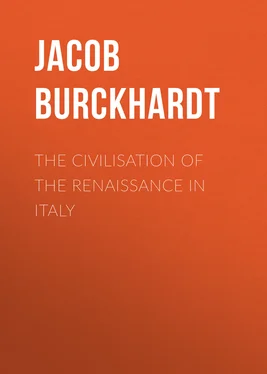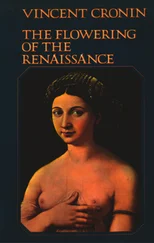Jacob Burckhardt - The Civilisation of the Renaissance in Italy
Здесь есть возможность читать онлайн «Jacob Burckhardt - The Civilisation of the Renaissance in Italy» — ознакомительный отрывок электронной книги совершенно бесплатно, а после прочтения отрывка купить полную версию. В некоторых случаях можно слушать аудио, скачать через торрент в формате fb2 и присутствует краткое содержание. Жанр: foreign_prose, История, foreign_edu, foreign_antique, на английском языке. Описание произведения, (предисловие) а так же отзывы посетителей доступны на портале библиотеки ЛибКат.
- Название:The Civilisation of the Renaissance in Italy
- Автор:
- Жанр:
- Год:неизвестен
- ISBN:нет данных
- Рейтинг книги:5 / 5. Голосов: 1
-
Избранное:Добавить в избранное
- Отзывы:
-
Ваша оценка:
- 100
- 1
- 2
- 3
- 4
- 5
The Civilisation of the Renaissance in Italy: краткое содержание, описание и аннотация
Предлагаем к чтению аннотацию, описание, краткое содержание или предисловие (зависит от того, что написал сам автор книги «The Civilisation of the Renaissance in Italy»). Если вы не нашли необходимую информацию о книге — напишите в комментариях, мы постараемся отыскать её.
The Civilisation of the Renaissance in Italy — читать онлайн ознакомительный отрывок
Ниже представлен текст книги, разбитый по страницам. Система сохранения места последней прочитанной страницы, позволяет с удобством читать онлайн бесплатно книгу «The Civilisation of the Renaissance in Italy», без необходимости каждый раз заново искать на чём Вы остановились. Поставьте закладку, и сможете в любой момент перейти на страницу, на которой закончили чтение.
Интервал:
Закладка:
At that time Raphael, a boy of twelve years of age, was at school under Pietro Perugino. The impressions of these days are perhaps immortalised in the small, early pictures of St. Michael and St. George: something of them, it may be, lives eternally in the great painting of St. Michael: and if Astorre Baglione has anywhere found his apotheosis, it is in the figure of the heavenly horseman in the Heliodorus.
The opponents of the Baglioni were partly destroyed, partly scattered in terror, and were henceforth incapable of another enterprise of the kind. After a time a partial reconciliation took place, and some of the exiles were allowed to return. But Perugia became none the safer or more tranquil: the inward discord of the ruling family broke out in frightful excesses. An opposition was formed against Guido and Ridolfo and their sons Gianpaolo, Simonetto, Astorre, Gismondo, Gentile, Marcantonio and others, by two great-nephews, Grifone and Carlo Barciglia; the latter of the two was also nephew of Varano, Prince of Camerino, and brother of one of the former exiles, Ieronimo della Penna. In vain did Simonetto, warned by sinister presentiment, entreat his uncle on his knees to allow him to put Penna to death: Guido refused. The plot ripened suddenly on the occasion of the marriage of Astorre with Lavinia Colonna, at Midsummer 1500. The festival began and lasted several days amid gloomy forebodings, whose deepening effect is admirably described by Matarazzo. Varano fed and encouraged them with devilish ingenuity: he worked upon Grifone by the prospect of undivided authority, and by stories of an imaginary intrigue of his wife Zenobia with Gianpaolo. Finally each conspirator was provided with a victim. (The Baglioni lived all of them in separate houses, mostly on the site of the present castle.) Each received fifteen of the bravos at hand; the remainder were set on the watch. In the night of July 15 the doors were forced, and Guido, Astorre, Simonetto, and Gismondo were murdered; the others succeeded in escaping.
As the corpse of Astorre lay by that of Simonetto in the street, the spectators, ‘and especially the foreign students,’ compared him to an ancient Roman, so great and imposing did he seem. In the features of Simonetto could still be traced the audacity and defiance which death itself had not tamed. The victors went round among the friends of the family, and did their best to recommend themselves; they found all in tears and preparing to leave for the country. Meantime the escaped Baglioni collected forces without the city, and on the following day forced their way in, Gianpaolo at their head, and speedily found adherents among others whom Barciglia had been threatening with death. When Grifone fell into their hands near S. Ercolono. Gianpaolo handed him over for execution to his followers. Barciglia and Penna fled to Varano, the chief author of the tragedy, at Camerino; and in a moment, almost without loss, Gianpaolo became master of the city.
Atalanta, the still young and beautiful mother of Grifone, who the day before had withdrawn to a country house with the latter’s wife Zenobia and two children of Gianpaolo, and more than once had repulsed her son with a mother’s curse, now returned with her step-daughter in search of the dying man. All stood aside as the two women approached, each man shrinking from being recognised as the slayer of Grifone, and dreading the malediction of the mother. But they were deceived: she herself besought her son to pardon him who had dealt the fatal blow, and he died with her blessing. The eyes of the crowd followed the two women reverently as they crossed the square with blood-stained garments. It was Atalanta for whom Raphael afterwards painted the world-famed ‘Deposition,’ with which she laid her own maternal sorrows at the feet of a yet higher and holier suffering.
The cathedral, in the immediate neighbourhood of which the greater part of this tragedy had been enacted, was washed with wine and consecrated afresh. The triumphal arch, erected for the wedding, still remained standing, painted with the deeds of Astorre and with the laudatory verses of the narrator of these events, the worthy Matarazzo.
A legendary history, which is simply the reflection of these atrocities, arose out of the early days of the Baglioni. All the members of this family from the beginning were reported to have died an evil death—twenty-seven on one occasion together; their houses were said to have been once before levelled to the ground, and the streets of Perugia paved with the bricks—and more of the same kind. Under Paul III. the destruction of their palaces really took place. 63 63 Julius II. conquered Perugia with ease in 1506, and compelled Gianpaolo Baglione to submit. The latter, as Macchiavelli ( Discorsi , i. c. 27) tells us, missed the chance of immortality by not murdering the Pope.
For a time they seem to have formed good resolutions, to have brought their own party into order, and to have protected the public officials against the arbitrary acts of the nobility. But the old curse broke out again like a smouldering fire. Gianpaolo was enticed to Rome under Leo X., and there beheaded; one of his sons, Orazio, who ruled in Perugia for a short time only, and by the most violent means, as the partisan of the Duke of Urbino (himself threatened by the Pope), once more repeated in his own family the horrors of the past. His uncle and three cousins were murdered, whereupon the Duke sent him word that enough had been done. 64 64 Varelin Stor. Fiorent. i. pp. 242 sqq.
His brother, Malatesta Baglione, the Florentine general, has made himself immortal by the treason of 1530; and Malatesta’s son Ridolfo, the last of the house, attained, by the murder of the legate and the public officers in the year 1534, a brief but sanguinary authority.
Here and there we meet with the names of the rulers of Rimini. Unscrupulousness, impiety, military skill, and high culture, have been seldom so combined in one individual as in Sigismondo Malatesta (d. 1467). 65 65 Comp. (inter. al.) Jovian. Pontan. De Immanitate , cap. 17.
But the accumulated crimes of such a family must at last outweigh all talent, however great, and drag the tyrant into the abyss. Pandolfo, Sigismondo’s nephew, who has been mentioned already, succeeded in holding his ground, for the sole reason that the Venetians refused to abandon their Condottiere, whatever guilt he might be chargeable with; when his subjects (1497), after ample provocation, 66 66 Malipiero, Ann. Venet., Archiv. Stor. vii. i. pp. 498 sqq. After vainly searching for his beloved, whose father had shut her up in a monastery he threatened the father, burnt the monastery and other buildings, and committed many acts of violence.
bombarded him in his castle at Rimini, and afterwards allowed him to escape, a Venetian commissioner brought him back, stained as he was with fratricide and every other abomination. Thirty years later the Malatesta were penniless exiles. In the year 1527, as in the time of Cæsar Borgia, a sort of epidemic fell on the petty tyrants: few of them outlived this date, and none to their own good. At Mirandola, which was governed by insignificant princes of the house of Pico, lived in the year 1533 a poor scholar, Lilio Gregorio Giraldi, who had fled from the sack of Rome to the hospitable hearth of the aged Giovanni Francesco Pico, nephew of the famous Giovanni; the discussions as to the sepulchral monument which the prince was constructing for himself gave rise to a treatise, the dedication of which bears the date of April in this year. The postscript is a sad one. 67 67 Lil. Greg. Giraldus, De Sepulchris ac vario Sepeliendi Ritu . Opera ed. Bas. 1580, i. pp. 640 sqq. Later edition by J. Faes, Helmstädt, 1676 Dedication and postscript of Gir. ‘ad Carolum Miltz Germanum,’ in these editions without date; neither contains the passage given in the text.—In 1470 a catastrophe in miniature had already occurred in the same family (Galeotto had had his brother Antonio Maria thrown into prison). Comp. Diario Ferrarese , in Murat. xxiv. col. 225.
—‘In October of the same year the unhappy prince was attacked in the night and robbed of life and throne by his brother’s son; and I myself escaped narrowly, and am now in the deepest misery.’
Интервал:
Закладка:
Похожие книги на «The Civilisation of the Renaissance in Italy»
Представляем Вашему вниманию похожие книги на «The Civilisation of the Renaissance in Italy» списком для выбора. Мы отобрали схожую по названию и смыслу литературу в надежде предоставить читателям больше вариантов отыскать новые, интересные, ещё непрочитанные произведения.
Обсуждение, отзывы о книге «The Civilisation of the Renaissance in Italy» и просто собственные мнения читателей. Оставьте ваши комментарии, напишите, что Вы думаете о произведении, его смысле или главных героях. Укажите что конкретно понравилось, а что нет, и почему Вы так считаете.












